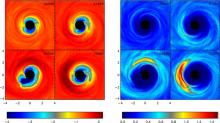
Abstract
As 2 black holes bound to each other in a close binary approach merger their inspiral time becomes shorter than the characteristic inflow time of surrounding orbiting matter. Using an innovative technique in which we represent the changing spacetime in the region occupied by the orbiting matter with a 2.5PN approximation and the binary orbital evolution with 3.5PN, we have simulated the MHD evolution of a circumbinary disk surrounding an equal-mass non-spinning binary. Prior to the beginning of the inspiral, the structure of the circumbinary disk is predicted well by extrapolation from Newtonian results. The binary opens a low-density gap whose radius is roughly two binary separations, and matter piles up at the outer edge of this gap as inflow is retarded by torques exerted by the binary; nonetheless, the accretion rate is diminished relative to its value at larger radius by only about a factor of 2. During inspiral, the inner edge of the disk at first moves inward in coordination with the shrinking binary, but as the orbital evolution accelerates, the rate at which the inner edge moves toward smaller radii falls behind the rate of binary compression. In this stage, the rate of angular momentum transfer from the binary to the disk slows substantially, but the net accretion rate decreases by only 10-20%. When the binary separation is tens of gravitational radii, the rest-mass efficiency of disk radiation is a few percent, suggesting that supermassive binary black holes in galactic nuclei could be very luminous at this stage of their evolution. If the luminosity were optically thin, it would be modulated at a frequency that is a beat between the orbital frequency of the disk's surface density maximum and the binary orbital frequency. However, a disk with sufficient surface density to be luminous should also be optically thick; as a result, the periodic modulation may be suppressed.